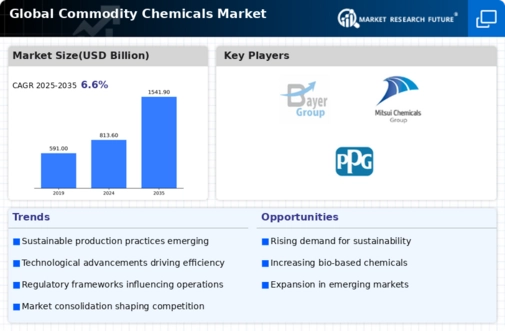Market Trends
Key Emerging Trends in the Commodity Chemicals Market
The global chemical industry has seen a number of major trends within its Commodity Chemicals Market. There have been significant shifts in demand for key chemicals, which are foundational to various sectors as economies continue to change. One such development has been a move towards greater sustainability. Commodity chemical players with environmental concerns now search for eco-friendly measures while they engage themselves in doing business. Additionally, technological advancements play a crucial role in influencing market trends of commodity chemicals. The sector is undergoing digitalization through the incorporation of high-end technologies such as artificial intelligence (AI), machine learning (ML), and automation, among others, which not only increase production efficiency but also improve predictability maintenance and use fewer resources, thereby lowering overall costs. Another notable trend is the focus on principles of the circular economy concept; companies want to minimize waste generated during production activities that produce commodity chemicals while maximizing the recycling of materials used herein. This transition into circular economy efforts blends with overall global attempts at creating more sustainable and ethical industrial environment systems across the world, respectively. Furthermore, these practices boost resource effectiveness and resilience when supply chains face disruption, among other setbacks globally. On the other hand, globalization continues to be one driver that shapes markets of commodity chemicals. This industry is now characterized by increased interconnectivity between markets across national borders, and therefore, companies are expanding their geographic presence. Consequently, this globalization has raised competitive forces in the market, and thus, enterprises must adopt new strategies so as to survive there. Additionally, this internationalized commodity chemicals market has opened doors for collaborations and partnerships among regional firms, hence promoting technology transfer through mutual learning. Regulation frameworks and geopolitics are also important factors that determine the dynamics of the commodity chemicals market. Strict environmental regulations influence the production processes and product formulations within the sector. As a result, corporations invest in cleaner technologies and sustainable practices since they have to adhere to these laws. There are also geopolitical tensions as well as trade policies that can affect the supply chain or/and even access to markets for certain types of commodities like chemical products, leading to strategic adjustments from major industry players.







Leave a Comment